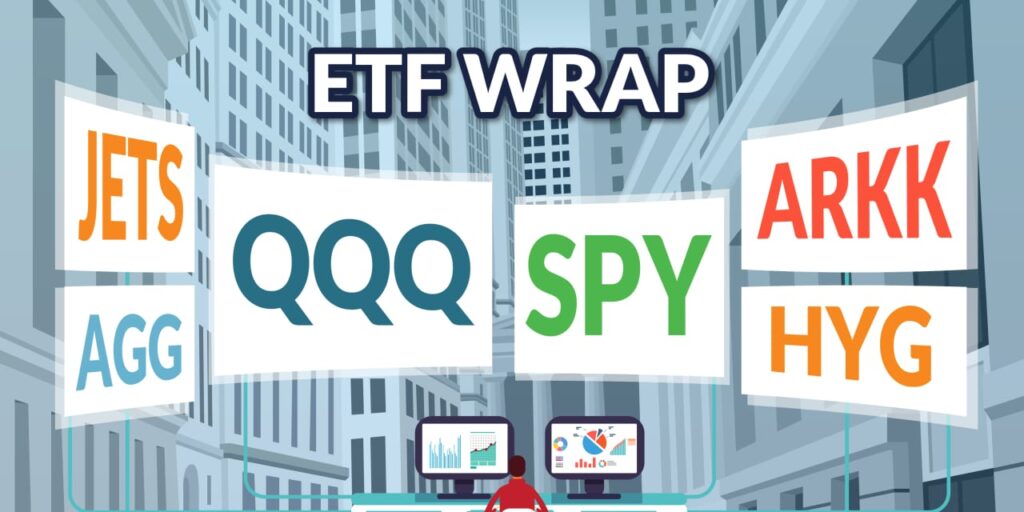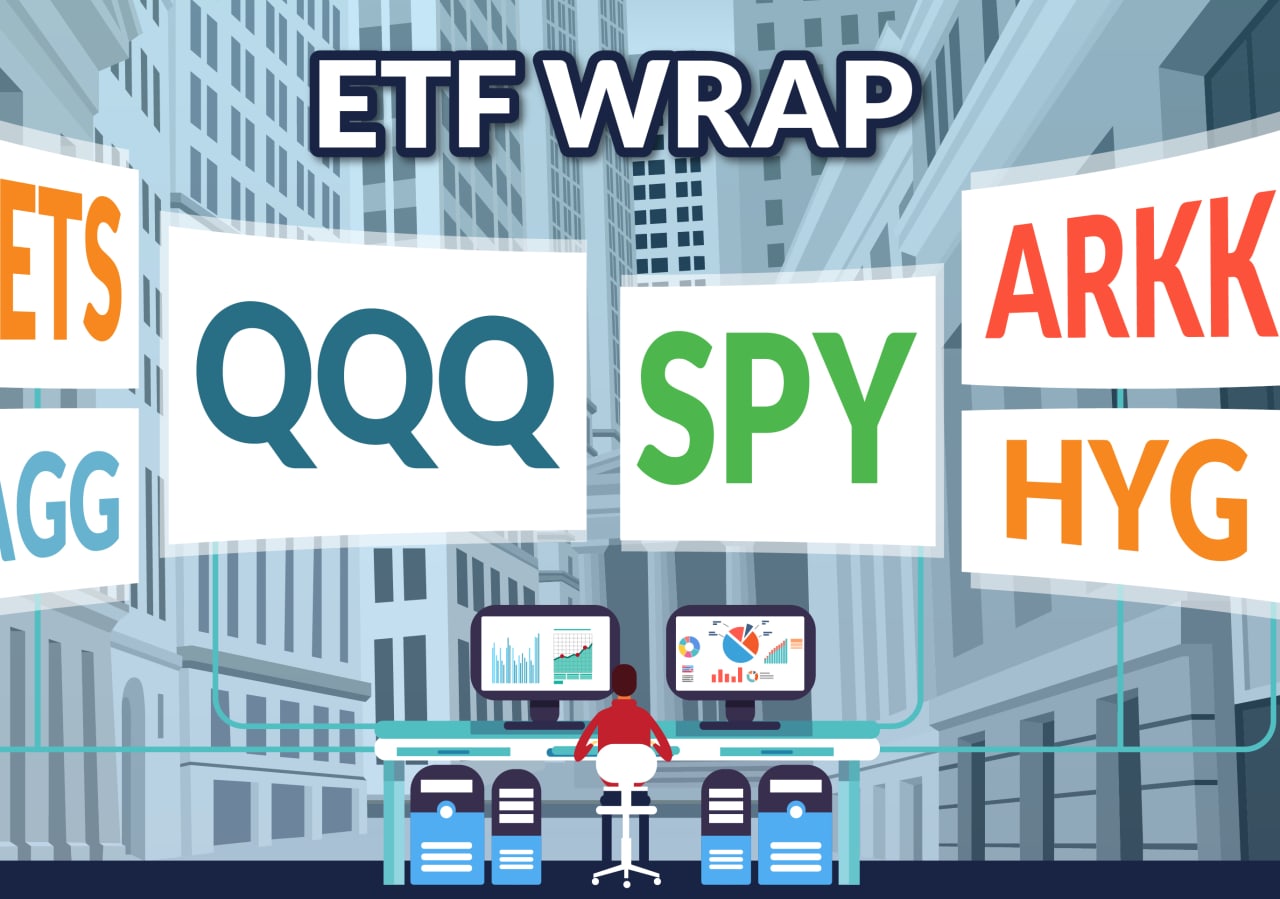‘The switch was flipped’: ETF flows pick up as stocks, bonds head for 2023 gains

Hello! Stocks and bonds are heading for gains in 2023 as ETF investors show signs of “more exuberance” in December. For this week’s ETF Wrap, State Street, Vanguard and BlackRock weigh in on the recent bullish sentiment and what’s ahead in 2024.
Please send feedback and tips to christine.idzelis@marketwatch.com or isabel.wang@marketwatch.com. You can also follow me on X at @cidzelis and find me on LinkedIn. Isabel Wang is at @Isabelxwang.
Sign up here for our weekly ETF Wrap.
U.S. stocks and bonds are up in 2023, in a big rebound from a brutal 2022.
The SPDR S&P 500 ETF Trust
SPY
has gained 25.5% this year on a total-return basis through Thursday, while the iShares Core U.S. Aggregate Bond ETF
AGG
and Vanguard Total Bond Market ETF
BND
have each returned more than 5% on a total-return basis over the same period, according to FactSet data.
Both stocks and bonds are rallying this quarter, continuing their climb after the Federal Reserve released its monetary policy statement and summary of economic projections on Dec. 13.
“It’s been a wild ride,” said John Croke, head of active fixed-income product management at Vanguard Group, by phone. “The market has become comfortable that the Fed has won the battle against inflation,” with many investors seeming to accept it has pulled off a “difficult-to-achieve” soft landing for the U.S. economy.
ETF flows show investors are “emboldened” to take on more risk in the markets, according to Matthew Bartolini, head of SPDR Americas research at State Street Global Advisors.
“November kicked it off,” Bartolini said by phone. “The switch was flipped.”
The massive SPDR S&P 500 ETF Trust saw a record daily inflow of $20.8 billion on Dec. 15, a sign of investor enthusiasm for risk-taking as well as a reflection of the positive holiday-season trend seen in the markets, according to Bartolini. He said the giant inflows also may have been influenced by the expiration of options contracts under so-called triple witching that day coinciding with the rebalancing of the S&P 500 index.
Last month’s flows into exchange-traded funds pointed to bullish buying of riskier assets as investors pulled capital from cash-like government bond funds. They returned to making tactical bets via sector-focused equity ETFs while also seeking exposure to high-yield, or so-called junk, bonds.
November was the first month this year with “sizeable flows” into ETFs, a trend that has accelerated so far in December, according to Bartolini.
‘Exuberance’
U.S.-listed ETFs have attracted more than $550 billion of inflows in 2023 as of Dec. 19, on pace to surpass $500 billion for a fourth straight year, Bartolini added. For the first time, their assets under management swelled to more than $8 trillion at the start of this week, he said.
Equities and bonds have posted gains in the U.S. this year, with investors expecting the Fed to begin cutting rates in 2024 as inflation has fallen significantly from its 2022 peak. Markets were battered last year as inflation surged and the Fed aggressively hiked rates in a bid to tame it.
Over the past two months, investor sentiment has shifted to “more exuberance,” said Bartolini. He said that “across the board, we’re seeing money pile in” risk assets in the ETF industry.
Meanwhile, Vanguard is “skeptical” that the Fed has pulled off “a soft landing” and is anticipating that the U.S. may see a “shallow recession” in the second half of next year, according to Croke.
As investors enter 2024, he notes they should add duration to their bond portfolios, as many have been overweight to cash and are “hiding in money markets.”
U.S. bonds look “fairly valued,” Croke added. Vanguard expects that bond investors will be much better rewarded over the long term, now that yields will likely remain higher than the levels seen before the Fed began hiking rates in early 2022, he said.
Read: Case for traditional 60-40 mix of stocks and bonds strengthens amid higher rates, according to Vanguard’s 2024 outlook
More active bond ETFs in 2024?
Demand for active bond ETFs has picked up, according to Vanguard and BlackRock.
Earlier this month Vanguard launched the Vanguard Core-Plus Bond ETF
VPLS
and Vanguard Core Bond ETF
VC
RB,
both of which are actively managed and run strategies similar to the firm’s existing mutual funds, according to Croke. The desire for active bond ETFs among Vanguard’s clients has grown “significantly” over the past 24 months, he explained.
The asset manager now offers three such funds, after launching its first actively managed fixed-income ETF in 2021, the Vanguard Ultra-Short Bond ETF
VUSB,
said Croke. “We don’t think we’re done here when it comes to active bond ETFs.”
The U.S. fixed-income ETF industry saw $26.5 billion of inflows in November, with iShares taking in $13.4 billion of that, according to BlackRock, the world’s largest asset manager.
This month, the firm launched the BlackRock Total Return ETF
BRTR,
a diversified core-bond fund that’s actively managed. That followed the May listing of the active BlackRock Flexible Income ETF
BINC.
“We’ve heard investors loud and clear that they would like to see these more-popular strategies in the ETF wrapper as well,” said Steve Laipply, global co-head of bond ETFs at BlackRock, by phone. “I do think that you will see us launch more active fixed-income ETFs next year.”
Read: BlackRock’s Rick Rieder rolls out his second ETF as active exchange-traded funds surge
Both index and active funds have a role in portfolios, with actively managed strategies aiming to produce excess returns, said Laipply.
For investors who would like to step out of cash — without taking a “strong view” on the possibility of a hard-landing scenario for the U.S. economy — “the belly of the curve looks attractive,” he added. Investors may consider turning to low-cost index strategies for exposure to that area of the bond market’s yield curve, he said, pointing to the iShares Core U.S. Aggregate Bond ETF
AGG
and the iShares Core Total USD Bond Market ETF
IUSB
as examples.
While yields have come down from their peak, “there’s still a tremendous opportunity for fixed income in 2024,” said Laipply. BlackRock is “very strong on this idea of moving out of cash and re-upping your allocation to fixed income.”
As usual, here’s your look at the top- and bottom-performing ETFs over the past week through Wednesday, according to FactSet data.
The good…
| Top Performers | %Performance |
|
SPDR S&P Metals & Mining ETF XME |
3.1 |
|
Amplify Transformational Data Sharing ETF BLOK |
2.8 |
|
United States Oil Fund LP USO |
2.4 |
|
First Trust Dow Jones Internet Index Fund FDN |
1.2 |
|
iShares S&P GSCI Commodity Indexed Trust GSG |
1.1 |
| Source: FactSet data through Wednesday, Dec. 20. Start date Dec. 14. Excludes ETNs and leveraged products. Includes NYSE-, Nasdaq- and Cboe-traded ETFs of $500 million or greater |
…and the bad
| Bottom Performers | %Performance |
|
iShares MSCI Taiwan ETF EWT |
-13.4 |
|
iShares Emerging Markets Equity Factor ETF EMGF |
-6.0 |
|
VanEck Vietnam ETF VNM |
-6.0 |
|
iShares Mortgage Real Estate ETF REM |
-5.7 |
|
Xtrackers Harvest CSI 300 China A-Shares ETF ASHR |
-5.6 |
| Source: FactSet data |
New ETFs
-
Texas Capital Bancshares announced on Thursday the launch of the Texas Capital Texas Small Cap Equity Index ETF
TXSS
and Texas Capital Texas Oil Index ETF
OILT. -
ProShares said Dec. 20 that it launched the ProShares S&P 500 High Income ETF
ISPY,
which seeks to track the performance of the S&P 500 Daily Covered Call Index. The firm said the index is “designed to replicate a daily covered-call strategy that sells call options with one day to expiration each day.” -
PGIM Investments announced Dec.19 that it launched four actively managed ETFs: the PGIM Jennison International Opportunities ETF
PJIO,
PGIM Jennison Better Future ETF
PJBF,
PGIM Jennison Focused Mid-Cap ETF
PJFM
and the PGIM Short Duration High Yield ETF
PSH.









